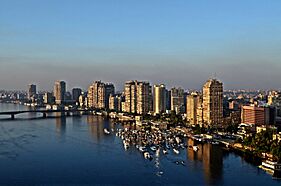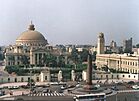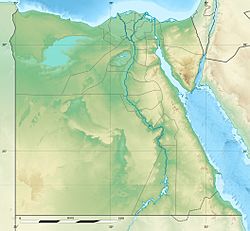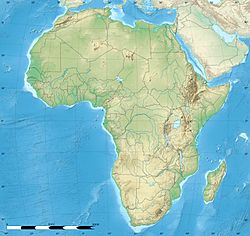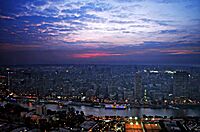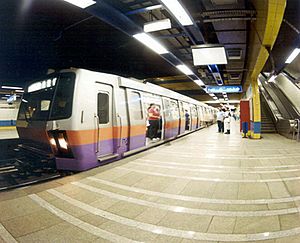Giza facts for kids
Quick facts for kids
Giza
الجيزة
|
|||
|---|---|---|---|
|
Clockwise from top:
Giza panorama, Pyramids of Giza, Cairo University, Great Sphinx of Giza, aerial view of Pyramids |
|||
|
|||
| Country | |||
| Governorate | Giza | ||
| Founded | 642 AD | ||
| Area | |||
| • Total | 98.4 km2 (38.0 sq mi) | ||
| Elevation | 30 m (100 ft) | ||
| Population
(2021)
|
|||
| • Total | 4,367,343 | ||
| • Density | 44,384/km2 (114,950/sq mi) | ||
| • Demonym | Gizan (m) Gizanne (f) | ||
| Time zone | UTC+2 (EST) | ||
| Postal code |
5-Digit
|
||
| Area code(s) | (+20) 2 | ||
| Website | Giza.gov.eg | ||
Giza is a very old and important city in Egypt. It's the third-largest city in Egypt by area, after Cairo and Alexandria. It's also one of the biggest cities in Africa.
Giza is the capital of the Giza Governorate. In 2017, about 4.8 million people lived there. The city is on the west side of the Nile River, right across from central Cairo. It's part of the larger area called Greater Cairo. Giza is close to Memphis, which was the capital of ancient Egypt around 3100 BC.
Giza is most famous for the Giza Plateau. This is where you can find some of the world's most amazing ancient buildings. These include the Great Sphinx, the Great Pyramid of Giza, and many other large pyramids and temples. Giza has always been a key place in Egypt's history because it's so close to Memphis, the old capital.
Contents
Giza's City Layout and Population
The city of Giza is the main city of the Giza Governorate. It's located near the northeast edge of this area.
How Giza is Divided
Giza city is like a big town with its own leader. It has nine main areas called districts and five newer areas called new towns. These new towns are managed by a special group called the New Urban Communities Authority (NUCA).
In 2017, about 4,872,448 people lived in Giza's districts. Some of the new towns, like Sheikh Zayed City and 6 October, also have many residents. There are also some islands in the Nile River that are part of Giza, like Qorsaya Island and Al-Warraq Island.
Geography and Climate of Giza
Giza's most famous area is the Giza Plateau. This is where you'll find the Great Sphinx and the famous pyramids of Giza. These pyramids were built overlooking the ancient Egyptian capital city of Memphis. The Nile River used to flow much closer to the Giza Plateau.
Giza's Weather
Giza has a very dry and hot desert climate. This is similar to the weather in Cairo because the cities are very close. Sometimes, in spring (March and April), strong winds can blow dust from the Sahara Desert into the city.
In winter, the temperature during the day is usually between 16 and 20 degrees Celsius. At night, it can get colder, sometimes below 7 degrees Celsius. In summer, it gets very hot, with daytime temperatures reaching 40 degrees Celsius. Nights are warmer, around 20 degrees Celsius. It doesn't rain much in Giza, and snow is extremely rare.
The hottest temperature ever recorded in Giza was 46 degrees Celsius on June 13, 1965. The coldest was 2 degrees Celsius on January 8, 1966.
| Climate data for Giza | |||||||||||||
|---|---|---|---|---|---|---|---|---|---|---|---|---|---|
| Month | Jan | Feb | Mar | Apr | May | Jun | Jul | Aug | Sep | Oct | Nov | Dec | Year |
| Record high °C (°F) | 28 (82) |
30 (86) |
36 (97) |
41 (106) |
43 (109) |
46 (115) |
41 (106) |
43 (109) |
39 (102) |
40 (104) |
36 (97) |
30 (86) |
46 (115) |
| Mean daily maximum °C (°F) | 19.3 (66.7) |
20.9 (69.6) |
24.2 (75.6) |
28.4 (83.1) |
32.0 (89.6) |
34.9 (94.8) |
34.5 (94.1) |
34.4 (93.9) |
32.4 (90.3) |
30.2 (86.4) |
25.4 (77.7) |
21.1 (70.0) |
28.1 (82.6) |
| Daily mean °C (°F) | 13.0 (55.4) |
14.0 (57.2) |
17.2 (63.0) |
20.5 (68.9) |
24.0 (75.2) |
27.1 (80.8) |
27.5 (81.5) |
27.5 (81.5) |
25.6 (78.1) |
23.5 (74.3) |
19.2 (66.6) |
15.0 (59.0) |
21.2 (70.1) |
| Mean daily minimum °C (°F) | 6.8 (44.2) |
7.2 (45.0) |
10.3 (50.5) |
12.7 (54.9) |
16.1 (61.0) |
19.3 (66.7) |
20.6 (69.1) |
20.7 (69.3) |
18.9 (66.0) |
16.8 (62.2) |
13.0 (55.4) |
8.9 (48.0) |
14.3 (57.7) |
| Record low °C (°F) | 2 (36) |
4 (39) |
5 (41) |
8 (46) |
11 (52) |
16 (61) |
17 (63) |
17 (63) |
16 (61) |
11 (52) |
4 (39) |
4 (39) |
2 (36) |
| Average precipitation mm (inches) | 4 (0.2) |
3 (0.1) |
2 (0.1) |
1 (0.0) |
0 (0) |
0 (0) |
0 (0) |
0 (0) |
0 (0) |
0 (0) |
3 (0.1) |
4 (0.2) |
17 (0.7) |
| Source 1: Climate-Data.org | |||||||||||||
| Source 2: Voodoo Skies for record temperatures | |||||||||||||
History of Giza
Ancient Times
The area where Giza is today was once a burial ground for many pharaohs (ancient Egyptian kings). This was during the second millennium BC. Three of their tombs are the giant pyramids you see at the famous Giza pyramid complex. This complex includes the Great Pyramid of Giza.
From Classical to Medieval Times
Over many years, ancient Egypt was ruled by different groups, including the Persians, Greeks, Romans, and Byzantines. The area of Giza also changed hands during these times.
When Muslims from the Islamic caliphate began to conquer Egypt in 639 AD, they took over the whole land by 641 AD. A year later, in 642 AD, they founded the city of Giza. No one is completely sure how Giza got its name. Some think it means "edge" or "side," possibly referring to the pyramids.
Modern Giza and Its Buildings
Giza has changed a lot over time. When different rulers, like the British, were in charge of Egypt, they built many roads, streets, and buildings in Giza. Today, Giza is a busy center of Egyptian culture. It has many facilities and buildings.
The ancient Egyptian monuments on the Giza Plateau have always drawn thousands of visitors and tourists. Because tourism is so important, both the British government (before 1952) and the current Egyptian government have paid a lot of attention to Giza's infrastructure. Giza is also home to St. George Cathedral, an important church for the Coptic Catholic faith.
The city has the first zoo in all of Africa, the Giza Zoo. It's also one of the oldest zoos in the Mediterranean region. There are also several parks, like Orman Park, which means "Forest Park" in Turkish.
Getting Around Giza
Getting around Giza is easy with its many roads, train system, subway, and boat services. You can travel by car, taxi, public buses, or smaller microbuses.
Giza shares a subway system with Cairo, called the "Metro." It's a fast way to move around. A large network of roads connects Giza to 6th of October City, Cairo, and other cities. There are also bridges and flyovers, like the 15th of May Bridge. Traffic in Giza can be very busy and crowded.
Other ways to travel include:
- Cairo Taxi
- Uber (available since 2015)
- Careem (available since 2015)
- Swvl (available since 2017)
- Water taxis (motorized boats called feluccas) can take you to places along the Nile River.
Giza's Economy
Giza has many different industries. These include making movies, chemicals, Giza cotton, machinery, and cigarettes. Also, Giza has many fancy apartment buildings along the Nile River, making it a popular place to live.
Getting to Giza from Other Countries
To get to Giza from other countries, most people fly into Cairo International Airport. There is another airport in Giza called the Imbaba Airport, but the Egyptian government plans to close it and turn the area into a cultural or sports center.
The Sphinx International Airport opened in 2018. It helps reduce traffic at Cairo International Airport. It also makes it easier for tourists to visit the Giza pyramids and the Grand Egyptian Museum.
Education in Giza
Giza is a big center for learning. It's home to Cairo University, which moved to Giza in 1924. The city offers many educational services not just for Egypt, but for the whole Mediterranean Region. Giza has many schools, kindergartens, and places for higher education.
There are also international schools in Giza, like the Cairo Japanese School and the Deutsche Evangelische Oberschule (a German international school) in Dokki.
Sports in Giza
Giza is home to El Zamalek, one of the most successful sports clubs in Egypt and Africa. It's located in the Meet Okba area. Other sports clubs in Giza include El Tersana and Seid Shooting Club.
Sister Cities
Giza has "sister city" relationships with other cities around the world. This means they share cultural and educational ties.
Giza is twinned with:
 Bandar Seri Begawan, Brunei Darussalam
Bandar Seri Begawan, Brunei Darussalam Bergen, Norway
Bergen, Norway Los Angeles, United States
Los Angeles, United States Rinkeby, Stockholm, Sweden
Rinkeby, Stockholm, Sweden
Notable People
- Amr Abou El Seoud (born 1968), a bank CEO
See also
 In Spanish: Guiza para niños
In Spanish: Guiza para niños


